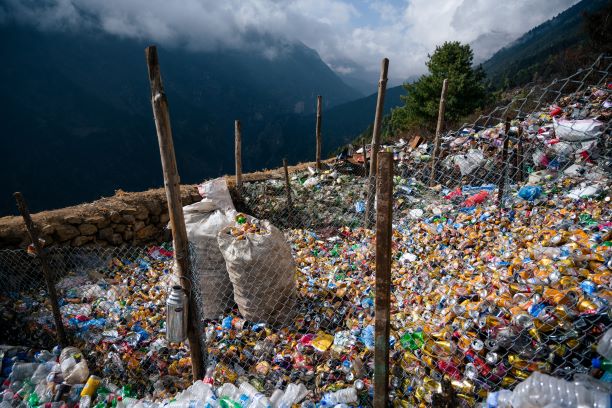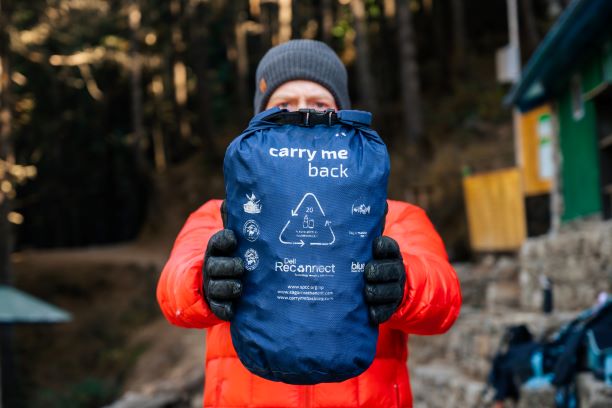In recent decades, the region around Mount Everest in Nepal has become an increasingly popular tourist destination, something that has had a major impact on the region’s culture and ecology. On one hand, the massive growth in tourism has led to increased revenue for the local tourism industry; but on the other hand, it has also caused an ecological disaster for the remote mountain villages that have become Nepal’s epicenter of mass tourism. The hope now lies in a unique self-help solution and the world’s highest situated museum.
The Khumbu Valley in Nepal, which houses Sagarmatha National Park, was once an isolated wilderness. However, since Edmund Hillary and Tenzing Norgay’s famous first ascent of Mount Everest, the region has attracted an ever-increasing stream of visitors – climbers and regular tourists alike. In total, almost a hundred thousand people hike through this fragile ecosystem every year.
The huge increase in visitors has put great strain on the natural environment and has literally produced mountains of waste. The absence of recycling options in this inaccessible part of the world – where everything from provisions to hygiene products and climbing equipment is carried up the mountains – has created an environment where local people’s livestock are forced to graze on lands covered in plastic and a mountain consisting of tens of thousands of metric tons of waste.
and has literally produced mountains of waste. The absence of recycling options in this inaccessible part of the world – where everything from provisions to hygiene products and climbing equipment is carried up the mountains – has created an environment where local people’s livestock are forced to graze on lands covered in plastic and a mountain consisting of tens of thousands of metric tons of waste.
Tourism generates more than 250 tons of waste each year, from the Everest base camp and the perilous “death zone”, to the local villages and communities that have long resided in the Khumbu Valley prior to the arrival of mass tourism.
Real change at high altitude

In response to the growing waste problems, the initiative Sagarmatha Next, a non-profit NGO run by local enthusiasts, was established. They have, among other things, built the world’s highest situated museum, a visitors’ center aimed at reducing the waste stemming from the tens of thousands of travelers visiting the region through education/inspiration and other activities.
The idea of a museum came after a cleaning expedition, ‘Saving Everest’, where rubbish was collected from the mountain range. Together with local organizations such as the Sagarmatha Pollution Control Committee/SPCC – and with help from companies such as Dell Technologies who have contributed with computers, interactive screens, projectors and more – the museum has gone from an idea to reality.
The new center is located at an altitude of 3,775 meters on the very path to Mount Everest and in addition to exhibitions about the national park and the waste problem, it also has an art gallery and a waste lab that explores new ways of turning waste into art.
“Carry Me Back”

Informing visitors about the waste problem is crucial, but as a stand-alone measure, it does not address the real practical problems at hand. Therefore, the Carry Me Back initiative was launched – providing tourists with bags full of collected and shredded waste from the mountains.
On the trek down from the mountains, the tourists are able to pick up a “Carry Me Back”-bag weighing less than a kilo – or as many as they feel they can manage (the record is 14) – and then drop these bags off lower down in the valley where they can be transported to recycling facilities in Kathmandu so that the waste can be recycled. The bags are then brought back up the mountain – they are repacked with shredded waste and picked up by new trekkers – and now a circular system is in place, reducing the waste problem and promoting responsible tourism practices.
Following a successful pilot, the project is now operating at a large scale and is expected to soon reach a “break even” in terms of the amount of waste generated equaling the amount being recycled. In the long run, the goal is to reduce the large piles of waste in this hard-to-access region. This simple yet effective initiative is funded by Dell Technologies and is loved by the tourists – as they themselves can easily contribute to the solution by carrying down their own waste to be recycled.
Collaborative efforts for sustainable tourism in the Khumbu Valley
For the oldest monks and the new generations of villagers in the Khumbu Valley, tourism has changed their lives in various ways, both in a positive and negative way. In the past, the locals never faced any waste management issues. However, with the rise of tourism, the natural processes previously adequate for managing waste, such as decomposing organic matter, are no longer effective, making the waste generated by tourism, including metal cans and plastic, a growing concern.
Therefore, these initiatives by SPCC and Sagarmatha Next are playing a vital role in ensuring that the local population and tourism can coexist harmoniously in the region – sustaining the tourism industry, which is crucial to the region’s economy and the locals’ livelihood.
Even though it hasn’t been that long since these initiatives were launched, the efforts have led to tremendously positive results. For instance, through the Carry Me Back initiative, thousands of visitors have collected and recycled thousands of kilos of trash.
This stunning and remote area, home to some of the tallest mountains on Earth, will always be a popular destination for visitors and climbers. By working collaboratively on both local and global levels, we can all help alleviate concerns and minimize the amount of waste on the mountains, allowing the world-renowned peaks to once again become the center of attention.
Powered by
In the best of worlds technology can enable engagement and drive change. If you are on top of the world, that technology needs to work at high altitude. That is why the experience center Sagarmatha Next is powered by:
- 55” large format touch monitor
- OptiPlex Micro 7080 PC
- Dell Advanced 4K Laser Projector S718QL
- Several Ultrasharp 32 4K monitors
- Several Latitude laptops
Photo: Martin Edström


